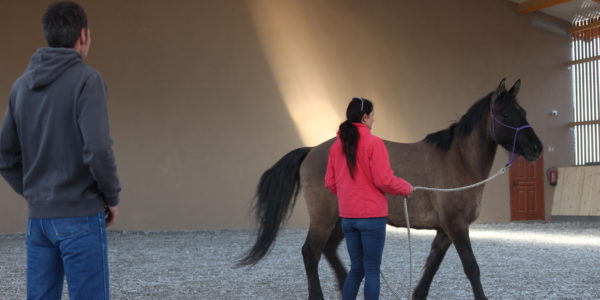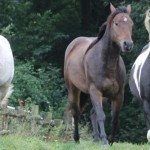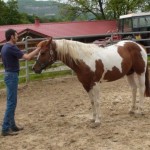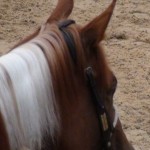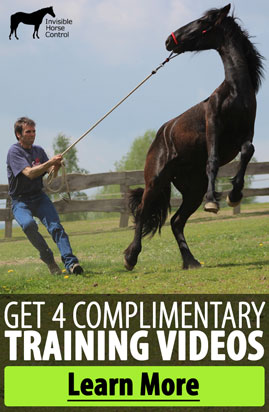When you go lunging you probably know why.
But are you aware of all the things that you can learn while lunging? There are a lot of things at every stage of the training process.
The very beginning of lunging
The first thing I practice while free lunging my horse is to just go around in walk, trot or canter. I want my horse to just follow the edge of the round pen and change direction when I ask for it.
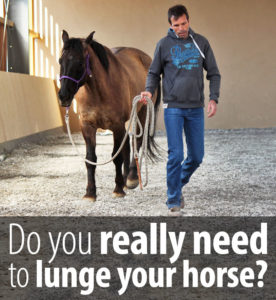
Pin this article on your Pinterest!
I don’t think that it matters whether your horse turns away from you, or towards you.
The only important thing is that he should be doing it the way you want.
As I progress I start practicing and improving transitions between walk, trot, and canter. I want to be able to ask my horse to change gaits by just adjusting my position in relation to him.
I walk more behind him, He speeds up, I get more in front of him, he slows down. When I am happy with the way I can switch between gaits, I start working with my horse on a lunge line, or a long lead rope.
I start with practicing asking my horse to make the circle bigger, I want him to make it bigger without trying to pull on the rope and drag me out as well. I want my horse to be on a loose rope while I ask him to make the circle bigger. I practice this in all gaits.
After you get comfortable with the basics
This was just the beginning of the training. I want my horse to react well when I ask for the basic things.
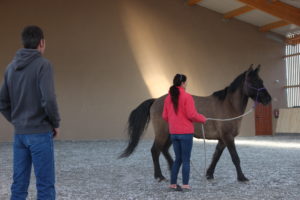 When I get confident with all these exercises, I start focusing on getting my horse to maintain a nice steady pace in canter.
When I get confident with all these exercises, I start focusing on getting my horse to maintain a nice steady pace in canter.
No young horse is likely going to be keeping a steady pace in canter. Running around the pasture is not really going to teach him that.
Keeping a steady pace in trot and canter is, after the very basics, one of the first things for your horse to learn in a round pen. Your horse is not going to be relaxed when he keeps slowing down and speeding up.
When he is going to learn to keep a steady pace, he is also going to relax.
Lunging can help your horse to become more comfortable under saddle
There is a big difference between riding on a horse that just can’t keep a steady pace when you have to keep adjusting yourself in the saddle and between riding on a horse that keeps a nice, steady, relaxed pace.
Lunging your horse is the easiest way to teach him to relax and maintain a nice steady pace.
Do this and your horse will learn how to react to the pressure from the bit even before you start riding
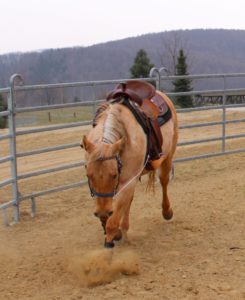 I also teach my horse to understand the pressure that comes from the bit during this stage.
I also teach my horse to understand the pressure that comes from the bit during this stage.
I just put the saddle on and use a side rein that prevents my horse from moving his head into certain positions.
It allows him to move it, of course, it just limits how much he can move it. If my horse carries his head in the correct position he doesn’t feel anything, if he tries to put it in the wrong position, the side rein doesn’t allow him to.
This helps him to understand how the pressure of the bit works. It teaches him that he should move away from it.
Lunging is crucial to keeping the back of your young horse healthy
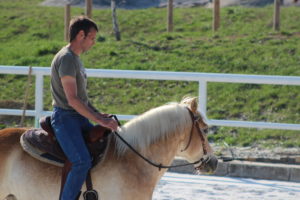 Another important thing that happens while you lunge your horse with side reins is that it helps him to exercise and strengthen his back muscles. Your horse will lower his head and arch up his back and neck.
Another important thing that happens while you lunge your horse with side reins is that it helps him to exercise and strengthen his back muscles. Your horse will lower his head and arch up his back and neck.
That basically means that the muscles your horse needs to carry you on his back, without getting back pain, will get stronger. When you start riding, he will be more prepared to carry your weight.
Your horse will be ready for you to start riding much sooner, and he won’t end up with medical issues and his back arched down and in pain.
Lunging is the most important during first two years of training
I do the most lunging during the first year of training before I even start to actually ride on my horse.
I do some lunging even during the second year of training. These are the basic things that I teach my horse while lunging.
Lunging is not there to just get your horse tired. Lunging is there to teach him something new.
Your horse always learns when you are around him. He either learns to be better or to be worse.
